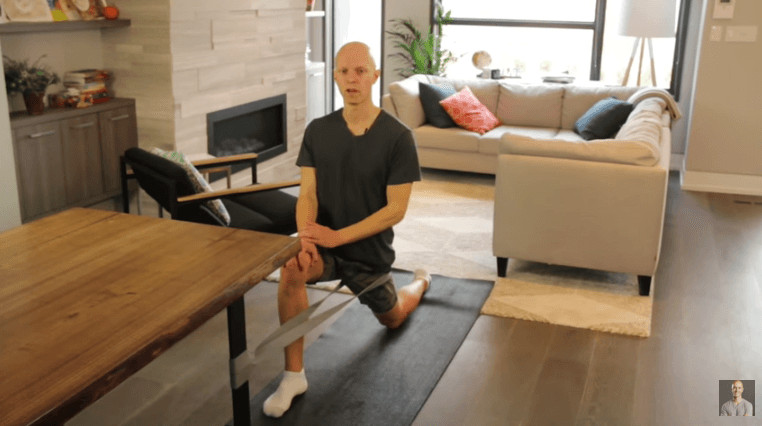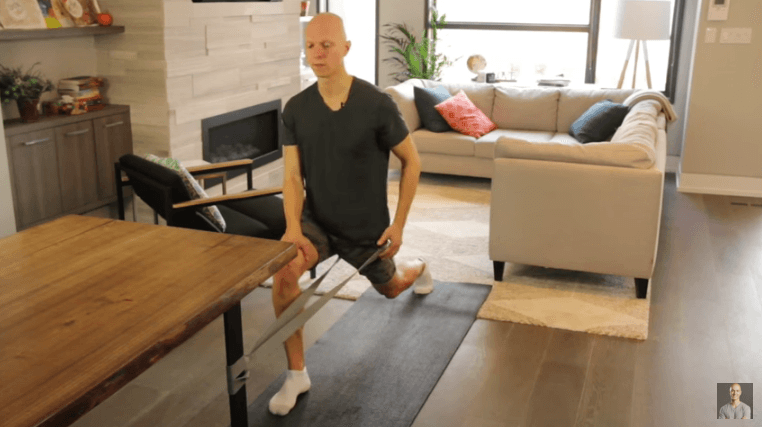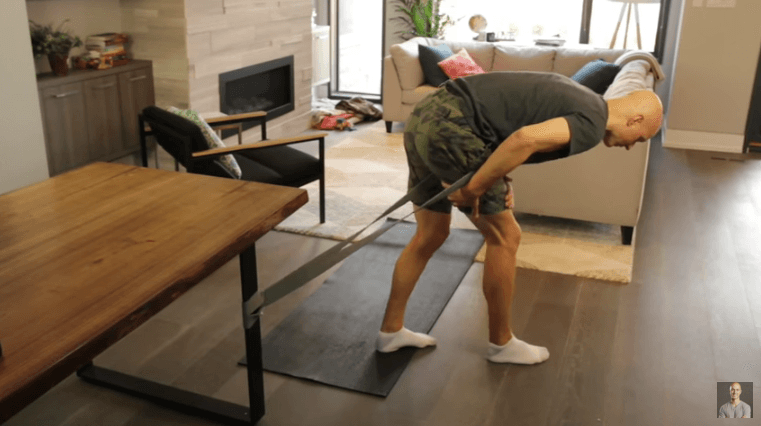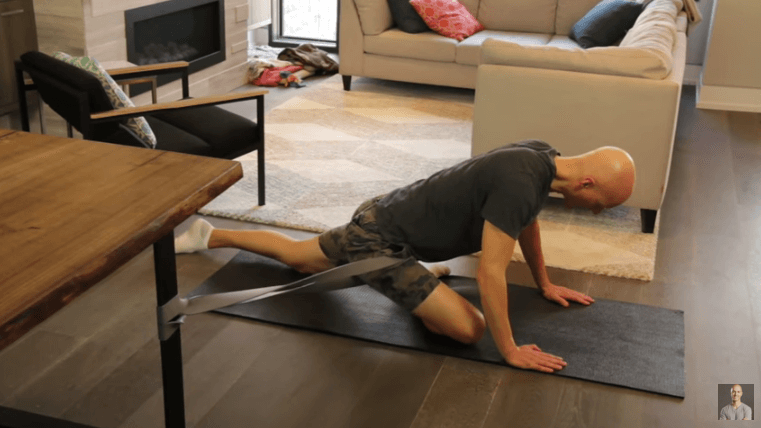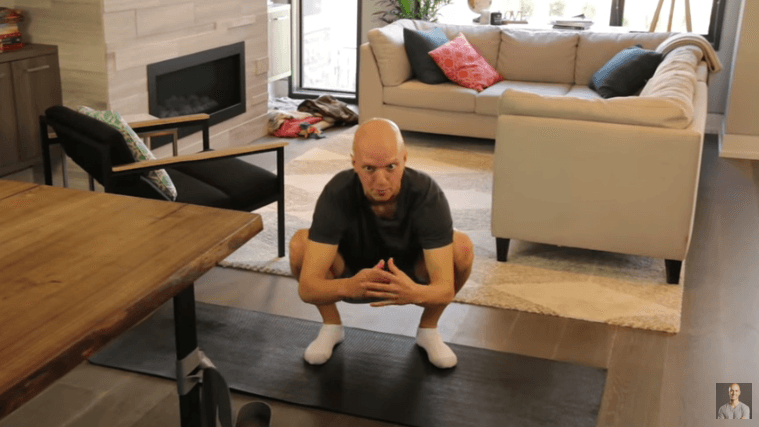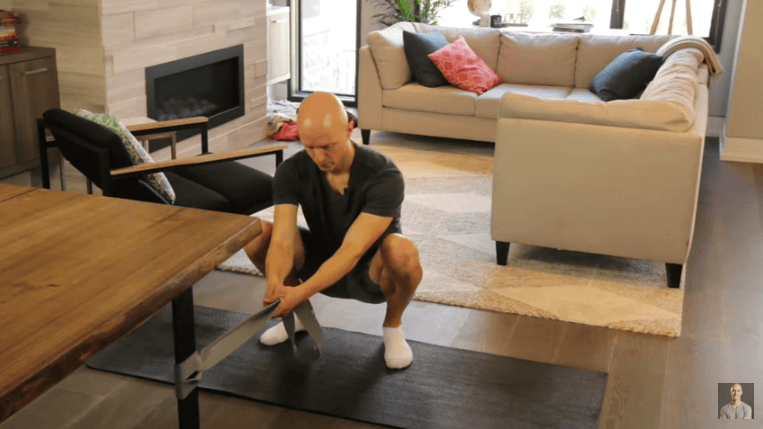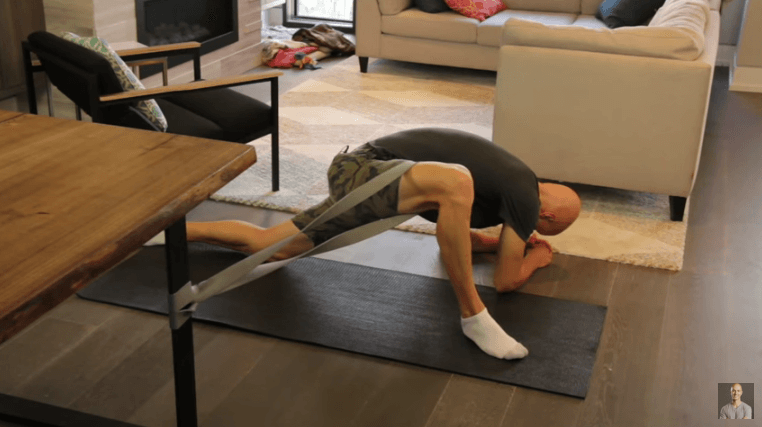Lately we’ve been talking a lot about opening up the muscles of your hip flexors, glutes, and hamstrings – for good reason.
In this article
Many of us get tight through those muscles because we sit a lot during the course of the day. And, as a result, we end up with back pain, posture problems, and muscle imbalances.
That’s why it’s really important to add stretches for hip flexors and the other muscles of the hip complex into our routines, whether it’s during your workout recovery session or at odd points during the day.
Because if we don’t, we’ll likely end up feeling the pain.
Try These Stretches for Hip Flexors
I’m going to show you how to use a heavy-duty stretch band to improve the your stretches and really take them to the next level.
The band I’m using is like a gigantic, super-strong elastic band, not a regular resistance band. It should be able to handle a lot of resistance.
You can find one of these stretch bands on Amazon as well as at most fitness stores.
The Fix for Tight Hip Flexors
For this stretch, you’re going to want to loop one end of the stretch band around a sturdy anchor – a heavy table, a post, something very strong – that can support your weight without sliding around.
Next, wrap the other end around your right upper thigh, and step back with that leg, into a long kneeling lunge.
Your left knee should be bent at 90 degrees, your right knee on the floor.
Beginner Hip Flexor Stretch
You’ll notice the band wants to pull you forward, which is going to really work to open the front part of your hips, which in turn will help release your hip flexor.
Be sure to engage your core, keep your torso tall, and really squeeze that right glute. You’ll feel the opposing-muscle contraction help to open up your hip flexor even more.
Now, from here, try to sit back a little bit, straightening that left knee a little bit, and come forward again. I like to call this a “nerve floss.”
I’m a big believer in dynamic movements to open things up. If you do that, be sure to keep that glute squeezed.
That’s step one.
To take it to step two, you will want to come up into a more conventional lunge, your right knee off the floor.
Dynamic (Advanced) Hip Flexor Stretch
You’ll immediately notice that this is more challenging.
What you will do from here is, while maintaining a tall, erect posture, simply drop that right knee down and up. Again, be sure to keep that right glute squeezed.
Do that about 10 times. Not only are your legs going to be burning as a little workout, but you instantly open up this huge space in those hips.
Helping the Hamstrings
To target the hamstring muscles, which are at the back of your thigh, you’ll want to turn around and face away from the anchor you’ve wrapped the band around.
This time, the band pulls against the front of your thigh, wanting to draw you backwards.
Stagger your stance so that the leg that the band is wrapped around is slightly forward. Both feet are flat on the floor.
Keeping your back flat, bend over so that you can feel the stretch along the back of your leg. From here, you can add that dynamic movement of slightly bending that knee and straightening it.
Dynamic Hamstring Stretch
This stretch gets that femur stuck into that ball-and-socket joint to stabilize the hip complex, which is great.
You also can also collapse your chest forward more, to open up some of the fascia through your back, or your posterior chain.
Ideally, you want to keep the back flat as you’re going through this, but you can play around with it.
You can move your upper body slightly from side to side, you can round out the back a little.
As you notice your muscles stretching and lengthening, you can start to take the stretch a little deeper by stepping forward. Or, you can hold on to a chair that’s placed arm’s length away in front of you, to provide support or to help you go deeper.
Advanced Hamstring Stretch
You want to give yourself a good amount of time on each leg. Give it a good thirty to sixty seconds minimum, and then build that up over time.
Stretching Out the Glutes
Next we’re going to target your glutes and outer hips. For these muscles, we’re going to perform a dynamic version of the pigeon pose from yoga.
For this one, you want to stand sidelong and slightly forward of the post anchoring your band.
Take the band and loop it around the upper thigh of the leg closest to your anchor.
Then, kneel into pigeon pose.
To do this, the leg that the band is wrapped around is bent in front of your body, knee at 90 degrees, the foot near the opposite hip bone.
The opposite leg stretches behind you.
Beginner Glute Stretch
As you will see, this really stretches out the hip and glute muscles of the bent leg. If you want, you can drop down to your elbows to deep the stretch.
From here, rock gently toward the anchor and then pull back to center, rocking back and forth.
You also can move around in a circular motion, clockwise and then counterclockwise.
Basically, you want to find that point of tension where you’re getting a good amount of action coming through mobility-wise in the hips.
This also stretches through the tiny – but often troublesome – piriformis muscle that’s deep inside in the glutes.
Opening Through the Groin
Before we get into this next stretch, let’s talk about the goal here.
One thing we want to be able to do is to sit into a deep squat, with our feet shoulder-width apart and facing straight ahead, knees aligned, and our butt dropping down below parallel.
Deep Squat Position
A lot of us have a tough time doing this. And if you can get into this position, it’s actually a good practice to sit in that position to open up some of those areas that are pretty inflexible.
For instance, this can even help with ankle mobility. If you have a tough time doing deeper squats, or even some deadlifts, ankle mobility can be a culprit. This kind of squat stretch can help.
If it’s challenging to remain in a deep squat, you can hold on to something placed in front of you, like the stretch band, which will also help you sit more upright.
Deep Squat with Balancing Aid
Many of us can’t can’t really open up our hips properly. You might notice that your knees cave in a little while doing holding this deep squat stretch. Your knees actually should remain aligned over your ankles.
With that in mind as our goal, let’s work to open up the groin a little bit.
Wrap the band around your upper thigh and go into a long extended lunge, again sidelong to your anchor. This lunge is a little wider than the one we did before, which will allow you to drop your upper body down beside your front knee.
The tendency is for the band to want to pull you toward the anchor.
You can stay nice and low to the front, or you can angle slightly away from the anchor to really feel the stretch through the groin. You also can play with the band placement, moving it closer to the knee to feel the stretch a little more deeply.
Groin Stretch
You want to find the optimal point to feel the stretch for you.
As you get more familiar with these stretches and positions, you’ll find that you can feel them a little more deeply, making them more effective. This band is a really great way to help you do that.
You’re going to feel a lot better after going through these stretches, which I personally do almost every day.
Get Limber with These Tips
Feeling a little stiff when you stand up after sitting?
You’ll want to check out my 11 little-known strategies to turn your body into a strong, supple machine. Check out my free Workout Recovery Formula, which you can download now for FREE by clicking the banner below.

